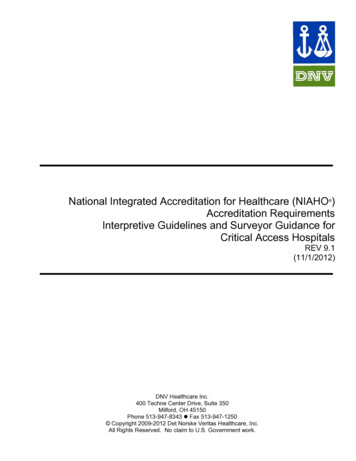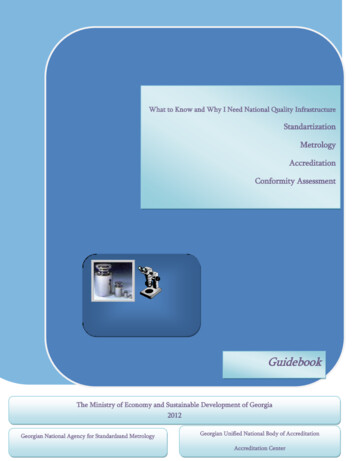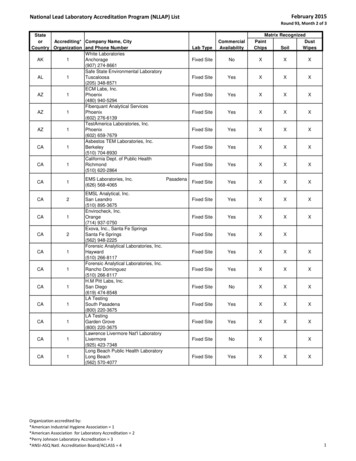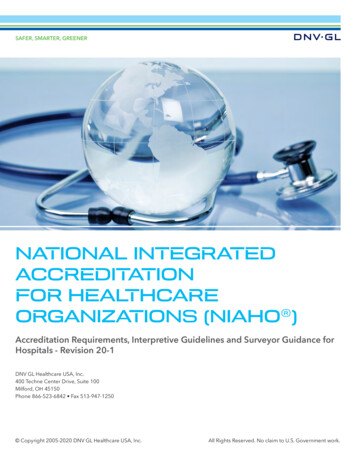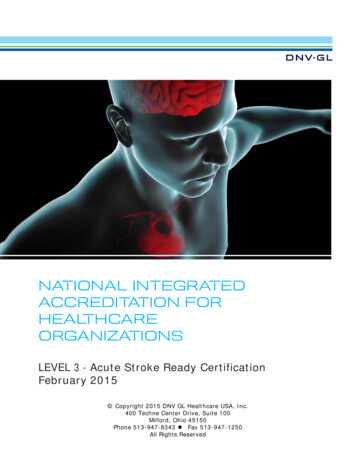
Transcription
DNV GL - HEALTHCARENATIONAL INTEGRATEDACCREDITATION FORHEALTHCAREORGANIZATIONSLEVEL 3 - Acute Stroke Ready CertificationFebruary 2015 Copyright 2015 DNV GL Healthcare USA, Inc.400 Techne Center Drive, Suite 100Milford, Ohio 45150Phone 513-947-8343 Fax 513-947-1250All Rights Reserved
Acute Stroke Ready Certification RequirementsASR 1.0Table of ContentsDNV GL - HEALTHCARE ACUTE STROKE READY CERTIFICATION REQUIREMENTS. 4INTRODUCTION .5ABBREVIATIONS AND DEFINITIONS. 7PROGRAM MANAGEMENT (PM) . 9PM.1 SENIOR MANAGEMENT . 9PM.2 MANAGEMENT COMMITMENT . 9PM.3 PROGRAM LEADERSHIP. 10QUALITY MANAGEMENT (QM). 11QM.1 QUALITY MANAGEMENT . 11QM.2 QUALITY OUTLINE/PLAN . 11QM.3 QUALITY OBJECTIVES . 11QM.4 QUALITY REPRESENTATIVE . 11QM.5 DOCUMENTATION AND PROGRAM REVIEW . 11QM.6 SYSTEM REQUIREMENTS . 12QM.7 MEASUREMENT, MONITORING, ANALYSIS . 12QM.8 PATIENT SAFETY SYSTEM . 13PATIENT CARE SERVICES (PC) . 14PC.1 PLANNING FOR SERVICE DELIVERY. 14PC.2 REVIEW OF REQUIREMENTS RELATED TO ASR SERVICE DELIVERY . 14PC.3 CONTROL OF SERVICE DELIVERY. 14PC.4 EMERGENCY DEPARTMENT (ED) . 15PC.5 EMERGENCY MEDICAL SERVICES . 17PC.6 TELEMEDICINE/TELESTROKE . 18PC.7 ACUTE STROKE TEAM (AST). 18PC.8 PROTOCOLS . 19PC.9 TRANSFER AGREEMENT . 20PC.10 PLAN OF CARE. 21PC.11 MEDICATION MANAGEMENT . 21PC.12 DIAGNOSTIC TESTS . 22PC.13 REHABILITATION SERVICES . 23PC.14 PATIENT/FAMILY/COMMUNITY EDUCATION . 24MEDICAL STAFF (MS) . 25MS.1 ADMISSION REQUIREMENTS (if admitted) . 25MS.2 CONSULTATION . 25MS.3 NEUROSURGICAL COVERAGE . 26NURSING SERVICES (NS) . 26NS.1 NURSING SERVICE . 26ASR 1.0 2015-02-15Page 2 of 35
Acute Stroke Ready Certification RequirementsASR 1.0STAFFING MANAGEMENT (SM) . 27SM.1 PERSONNEL (GENERAL) . 27SM.2 COMPETENCE, TRAINING AND AWARENESS. 27SM.3 DETERMINING AND MODIFYING STAFFING . 28SM.4 JOB DESCRIPTION . 28SM.5 ORIENTATION . 28SM.6 STAFF EVALUATIONS. 28PATIENT RIGHTS (PR) . 29PR.1 SPECIFIC RIGHTS . 29PR.2 ADVANCE DIRECTIVE . 30PR.3 LANGUAGE AND COMMUNICATION. 30PR.4 INFORMED CONSENT . 30PR.5 GRIEVANCE PROCEDURE . 31MEDICAL RECORDS (MR) . 31MR.1 ORGANIZATION . . . 31MR.2 CONFIDENTIALITY . 32MR.3 RECORD CONTENT . 32MR.4 REQUIRED DOCUMENTATION . 33PHYSICAL ENVIRONMENT (PE) . 34Professional References . 35ASR 1.0 2015-02-15Page 3 of 35
Acute Stroke Ready Certification RequirementsASR 1.0DNV GL - HEALTHCARE ACUTE STROKE READY CERTIFICATION REQUIREMENTSEffective DateThis DNV GL - Healthcare Acute Stroke Ready Certification Requirements, ASR 1.0 EffectiveDate: January 1, 2015.Federal Laws, Rules and RegulationsThe Acute Stroke Ready (ASR) Certification requirements are based in whole or in part of themost current recommendations from the Brain Attack Coalition (BAC), American HeartAssociation and the American Stroke Association. (AHA/ASA) and the Center for Medicare andMedicaid (CMS) Conditions of ParticipationThe most current version of Federal law and the Code of Federal Regulations referenced in thisCertification Program document are incorporated herein by reference and constitute, in part,Acute Stroke Ready Certification requirements.ASRs, through their association to the Hospitals participating in the Medicare and Medicaidprogram, are expected to comply with current Conditions of Participation. When new or revisedrequirements are published, ASRs are expected to demonstrate compliance in a time frameconsistent with the effective date as published by CMS in the Federal Register and/or asrequired by DNVGL Healthcare.ASR 1.0 2015-02-15Page 4 of 35
Acute Stroke Ready Certification RequirementsASR 1.0DNV GL - HEALTHCARE ACUTE STROKE READY CERTIFICATIONINTRODUCTIONThe Acute Stroke Ready (ASR) Certification Program is offered by DNV GL - Healthcare(DNV GL- HC) and integrates requirements related to the Guidelines of the Brain AttackCoalition, the recommendations of the American Heart Association, the American StrokeAssociation and to the CMS Conditions of Participation for hospitals (CoPs)ASRs are designed to be a part of a larger stroke system of care which will include all levels ofstroke care.The stroke-ready certification will mean that a hospital is equipped to evaluate,stabilize and provide emergency care to patients with acute stroke symptoms. The intent of theASR is to provide initial diagnostic services, stabilization, emergent care and therapies topatients with an acute stroke who are seen in the emergency department. In most cases, theASR would be in a remote location and not in a densely populated urban or suburban areawhere there might be a nearby PSC or CSC.An ASR hospital has the infrastructure and capability to care for acute stroke, includingadministration of intravenous thrombolytic therapy (also known as tissue plasminogen activator“tPA,” or alteplase).An ASR has fewer overall capabilities than a Primary Stroke Center, but has staff and resourcesable to diagnose, stabilize, treat, and transfer most patients with stroke. Most acute strokepatients may be transferred to a Primary Stroke Center or a Comprehensive Stroke Center thatwould provide ongoing care and/or endovascular procedures, as indicated, after initialtreatment and stabilization.If an ASR intends to admit many or most patients with an acute stroke, it is a recommendationthat the facility develop a stroke unit with elements and procedures similar to those of a strokeunit at a PSC.REGULATORY AND POLICY REFERENCE The Medicare Conditions of Participation for hospitals are in 42 CFR Part 482.The DNVGL HC Certification Process, Certification Requirements, and applicable CMSState Operations Manual (SOM) provide the policies and procedures regardingcertification activities.American Stroke Association / American Heart Association - Guidelines for StrokePatients and Establishment of Stroke Systems of CareBrain Attack Coalition – Pathways and GuidelinesSurveyors assess the ASR’s compliance with the ASR Certification Requirements for servicesand locations in which the ASR operates for patient care services.Organizations seeking and maintaining Acute Stroke Ready certification must participate in theMedicare program and be in compliance with the CoPs by the Centers for Medicare andMedicaid Services (CMS). Compliance with the CMS CoPs may be demonstrated by maintainingASR 1.0 2015-02-15Page 5 of 35
Acute Stroke Ready Certification RequirementsASR 1.0accreditation with DNVGL- HC or another accreditation organization, approved by CMS to deemhealthcare organizations in compliance with the CoPs.This Certification Program addresses healthcare organizations that are either applying forDNV GL - Healthcare for certification in the Acute Stroke Ready Certification (ASR) Program orare currently certified by DNV GL - HC. When a healthcare organization has applied for but notreceived DNV GL - HC certification, it is referred to as an “Applicant Organization.” When ahealthcare organization is currently certified by DNV GL - HC, it is referred to as a “CertifiedOrganization.If the Certification Assessment is completed in conjunction with a DNVGL- HC AccreditationSurvey for the hospital, the assessment will not be announced to the ASR. If the CertificationAssessment is conducted separate and apart to a DNV GL Accreditation Survey, the ASR will beprovided advance notice of the upcoming survey not to exceed one month prior to theassessment of the ASR.Surveyor Information Gathering and InvestigationThe objective of assessment activities is to determine the ASR’s compliance with therequirements through observations, interviews, and document review. The surveyors will focus attention on actual and potential patient outcomes, as well asrequired processes.The surveyors will assess the care and services provided, including the appropriatenessof the care and services within the context of the certification requirements.The surveyors will visit the emergency room, imaging locations and other patient caresettings as appropriate to the level of services provided by the ASR.The surveyors will review clinical records, staff records, and other documentationnecessary to validate information gained from observations and interviews.The surveyors will review transfer agreements, telemedicine/tele-stroke capabilities andequipment.ASR 1.0 2015-02-15Page 6 of 35
Acute Stroke Ready Certification RequirementsASR 1.0ABBREVIATIONS AND DEFINITIONSAANNAmerican Association of Neuroscience NursesASR/Acute Stroke ReadyOrganization that can provide timely access to stroke care butnot able to meet all of the criteria for PSCs or CSCsAISAcute Ischemic StrokeAMAAmerican Medical AssociationABNNAmerican Board of Neuroscience NursingBACBrain Attack CoalitionCDCCenters for Disease Control and PreventionCEOChief Executive OfficerCFRCode of Federal RegulationsCMSCenters for Medicare Medicaid ServicesCRCertification RequirementCSCComprehensive Stroke CenterCSRNCertified Stroke Registered NurseDEADrug Enforcement AdministrationEMSEmergency Medical ServicesFDAFood and Drug AdministrationGCSGlasgow Coma Scale scoreIATRapid local delivery of thrombolytic agent through a microcatheter placed near the site of occlusionICHIntracerebral hemorrhageISMPInstitute for Safe Medication PracticesISOInternational Organization of StandardizationLife Safety CodeLife Safety Code of the National Fire Protection AssociationNIHSSNational Institutes of Health Stroke ScaleASR 1.0 2015-02-15Page 7 of 35
Acute Stroke Ready Certification RequirementsASR 1.0NFPANational Fire Protection AssociationPRN (prn)Pro re nata, as the occasion arises, when necessaryPrimary Stroke Center/PSCPrimary Stroke Centeracute care phaseincludes critical care units, intermediate care units, strokeunits, and general medical units.Hyper acute phaseincludes the pre-hospital setting and the emergencydepartment (ED)QMSQuality Management SystemTele-stroke/Tele-medicinean approach to treating vascular disease that allows aneurologist to provide remote treatment for a stroke victim.Electronic communications may include telephone, internet orvideo conferencing, providing consultation and diagnosticservices.TIATransient Ischemic AttacktPAtissue plasminogen activator (thrombolytic medication)Troponincomplex of three regulatory proteins (troponin C, troponin I,and troponin T) that is integral to muscle contraction inskeletal muscle and cardiac muscle. Often elevated afterstroke.ASR 1.0 2015-02-15Page 8 of 35
PROGRAM MANAGEMENT (PM)Acute Stroke Ready Certification RequirementsASR 1.0The ASR shall establish, document, implement and maintain the ASR Program and continuallyimprove its effectiveness in accordance with the requirements of this Certification Program.PM.1 SENIOR MANAGEMENTCR.1 Senior Management is responsible and accountable for ensuring that the following:CR.1a the ASR is in compliance with all applicable Federal and State laws regarding thehealth and safety of its patients;CR.1b the ASR is licensed by the appropriate State or local authority responsible forlicensing of ASR (if applicable);CR.1c Criteria that includes aspects of individual character, competence, training,experience and judgment is established for the selection of individuals working forthe ASR, directly or under contract and,CR.1d the personnel working in the ASR are properly licensed or otherwise meet allapplicable Federal, State and local laws.CR.1e responsibilities and authorities are defined and communicated to the ASR.CR.1f appointment and qualifications of the medical director for the ASRCR.1f(i) The medical director for the ASR must have sufficient knowledge of thediagnosis and treatment of cerebrovascular diseaseNote: The ASR medical director does not need to be board certified inneurology. The medical director can be an emergency room physician.PM.2 MANAGEMENT COMMITMENTSenior management shall provide evidence of its commitment to the development andimplementation of the ASR Program and continually improving its effectiveness by:CR.1 communicating to the ASR the importance of meeting customer as well as statutory andregulatory requirementsCR.2 establishing and assisting in meeting the ASR Programs mission, goals and objectives,CR.3 ensuring the availability of resources and information necessary to support the operationand monitoring of these processesASR 1.0 2015-02-15Page 9 of 35
Acute Stroke Ready Certification RequirementsASR 1.0PM.3 PROGRAM LEADERSHIPThe ASR program leadership shall:CR.1 define in writing the programs mission and scope of service which describes the design,implementation and evaluation of the processes needed for the ASR Program servicedelivery.CR.2 determine criteria and methods needed to ensure consistent, effective care andtreatmentCR.3 conduct program reviews to determine achievement towards goals, objectives andoutcomesCR.4 monitor, measure, and analyze program processes, andCR.5 implement actions necessary to achieve planned results and continual improvement ofthese processesASR 1.0 2015-02-15Page 10 of 35
QUALITY MANAGEMENT (QM)Acute Stroke Ready Certification RequirementsASR 1.0QM.1 QUALITY MANAGEMENTThe governing body (or organized group or individual who assumes full legal authority andresponsibility for operations of the Acute Stroke Ready(ASR)), medical staff, andadministrative officials are responsible and accountable for ensuring that the ASR implementsand is included in the host hospital quality management system. The host hospital will assurethat adequate resources are allocated for measuring, assessing, improving, and sustaining theASRs performance and reducing risk to patients.CR.1The ASR must be involved in and implement the host hospitals method for maintainingan ongoing system for managing quality and patient safety.CR.2The ASR must implement quality assessment and performance improvement efforts toaddress priorities for improved quality of care and patient safety and that corrective andpreventive actions are implemented and evaluated for effectiveness.CR.3 The ASR has established programmatic measurable quality objectives and the results areanalyzed addressed; andCR.4 Appropriate information from the ASR has been submitted to the host hospital oversightgroup for quality management.QM.2 QUALITY OUTLINE/PLANThe ASR shall clearly outline its methodology, practice and related policies for addressing howquality and performance are measured, monitored, analyzed and continually improved toimprove health outcomes and reduce risks for patients.QM.3 QUALITY OBJECTIVESSenior management shall ensure that ASR Program quality objectives, including those neededto meet requirements for the ASR Program are established. The quality objectives shall bemeasurable and consistent with the requirements of the ASR Certification Program.QM.4 QUALITY REPRESENTATIVEA quality representative shall be designated and shall have the responsibility and authority forensuring that the requirements of the ASR program are implemented and maintained.QM.5 DOCUMENTATION AND PROGRAM REVIEWCR.1 Any variation, deficiency or non-conformity identified by the ASR shall be addressed bythe stroke committee. Appropriate actions will be determined, applied, and documented.ASR 1.0 2015-02-15Page 11 of 35
Acute Stroke Ready Certification RequirementsASR 1.0CR.2 Review performed at regular intervals, at a minimum of once a quarter, with an annualevaluation of the effectiveness of the ASR program components and metrics.Note: Documentation of activities may take the form of a Failure, Mode and Effect Analysis,Root Cause Analysis, Performance Report, Non-Conformity Report, specific ImprovementProject analysis, etc.QM.6 SYSTEM REQUIREMENTSThe ASR will participate and follow the system requirements of the host hospital in establishinga quality system, the ASR shall be required to have the following as a part of this system:CR.1 An Interdisciplinary group to oversee the ASR specific quality data that includes themedical director of the ASR, the nurse stroke coordinator (or nurse practitioner orphysician’s assistant) and a quality facilitator. Other discipline representatives andpractitioners members are at the discretion of the ASR. This interdisciplinary group shallconduct quality and programmatic reviews;CR.2 A written document defining the quality oversight process, to include components of theASR clinical and non-clinical services;CR.3 Measurable quality objectives; and,CR.4 Goal Measurement / Prioritization of activities based in some manner on:CR.4a problem-prone areas, processes or functions,CR.4b the incidence, prevalence and severity of problems in these areas, processes orfunctions,CR.4c and effect on health outcomes, improve patient safety and quality of care.QM.7 MEASUREMENT, MONITORING, ANALYSISThe ASR should strive to optimize its overall effectiveness of processes and systems of theservice. This goal should be accomplished by identifying primary performance measures foreach component and for the system function as a whole (both process and outcomesmeasures) and by employing the methodologies for collaboration with key stakeholders.Evaluations of the ASR should encompass overall patient outcomes, linkages among keycomponents of the ASR, potential problems that impede the care provided under the ASR.Furthermore, the ASR should develop performance measures and strategies for measuring,refining and reassessing the following key system components:CR.1 Notification and EMS; including data exchange between EMS, ED and the Stroke Team sothat relevant pre-hospital data can be incorporated into the evaluation of effectiveness ofthe ASR.ASR 1.0 2015-02-15Page 12 of 35
Acute Stroke Ready Certification RequirementsASR 1.0NOTE: This data will capture stroke team response time to acute stroke patients, treatmentsused and patient disposition. It is the discretion of the ASR to determine the collectionof this data as to whether this is through written or electronic means and/or may bedone retrospectively through chart reviews.CR.2 Hyper acute stroke treatment with specific performance measures involving thetimeliness and effectiveness of the acute treatment of both ischemic and hemorrhagicstroke and the prevention of complications.CR.2a Door to physician 10 minutesCR.2b Door to stroke team 15 minutesCR.2c Door to CT/MRI initiation 25 minutesCR.2d Door to CT/MRI interpretation 45 minutesCR.2e Order to lab results 45 minutes, if orderedCR.2f Computer link from determined medically necessary by ED physician 20 minutes(if applicable)CR.2g Door to IV tPA bolus ( 50% compliance) 60 minutesCR.2h Transfer of patients to PSC/CSC 2 hours of ED arrival (or when medically stable)ORCR.2i Door to monitored bed admission 3 hours (if admitted)CR.3 Sub-acute care and secondary prevention including specific measures of patientoutcomes and avoidance of complications and recurrent strokes.(Core measures, applicable only if patients are admitted)CR.4 Rehabilitation with performance measures to evaluate patient outcomes (mortality,functional status, and community discharge) and the percentage of stroke patient whoreceive the appropriate level of rehabilitation services in the system(applicable only if patients are admitted).QM.8 PATIENT SAFETY SYSTEMCR.1 The ASR shall follow and participate in the host hospitals program for establishing clearexpectations for identifying and detecting the prevalence and severity of incidents thatimpact or threaten patient safety.ASR 1.0 2015-02-15Page 13 of 35
PATIENT CARE SERVICES (PC)Acute Stroke Ready Certification RequirementsASR 1.0PC.1 PLANNING FOR SERVICE DELIVERYThe ASR shall have a plan and develop the processes needed for ASR service delivery. Planningof the ASR service delivery shall be consistent with the certification requirements of theprocesses of the ASR Program. In planning service delivery, the ASR shall determine thefollowing, as appropriate, a written plan or description of:CR.1 quality objectives and requirements for the ASR;CR.2 the need to establish processes and documents, and to provide resources specific to theASR;CR.3 required verification, monitoring, and measurement, specific to the ASRCR.4 records needed to provide evidence that the processes meet requirements. The outputof this planning shall be in a form suitable for the ASR's method of operations.NOTE: While ASRs do not usually admit patients, there may be times when it is determinedthat a certain patient can have their care treated in the host hospital. There is nospecific requirement as to the design and location of a unit that would be considered astroke unit(s). The ASR can define the designation of a unit(s) and/or beds fortreatment of acute stroke patients. The ASR will identify a specified unit to which moststroke patients are admitted and criteria when this may vary. The staff and servicesprovided for these acute stroke patients will meet the specified requirements as definedunder the ASR.PC.2 REVIEW OF REQUIREMENTS RELATED TO ASR SERVICE DELIVERYThe ASR shall review the requirements related to the ASR Program. This review shall beconducted prior to the ASR's commitment to provide services to patients and shall ensure that:CR.1 ASR Program requirements are defined,CR.2 the ASR has the ability to meet the defined requirements.CR.3 Records of the results of reviews and actions shall be maintained.CR.4 When the ASR Program requirements are changed, the ASR shall ensure that relevantdocuments are amended and that relevant personnel are made aware of the changedrequirements.PC.3 CONTROL OF SERVICE DELIVERYThe ASR shall plan and carry out services under controlled conditions. Controlled conditionsshall include, as applicable,ASR 1.0 2015-02-15Page 14 of 35
Acute Stroke Ready Certification RequirementsASR 1.0CR.1 the availability of information that describes the characteristics of the ASR Program,CR.2 the availability of policies, procedures, protocols, as necessary,CR.3 the availability, use and monitoring of suitable equipment,PC.4 EMERGENCY DEPARTMENT (ED)CR.1 The ASR is responsible for developing and maintaining pathways, protocols andprocesses to rapidly identify, evaluate and treat potential stroke patients.CR. 2 Emergency Department practitioners and staff demonstrate knowledge andunderstanding of the stroke protocol in place, including effective communication withEMS personnel, notification of the stroke team and initiation of the stroke protocolconcurrent with the ED evaluation and management.CR.3 The emergency department practitioners and staff demonstrate knowledge in thedelivery of acute therapies that can improve a patient’s outcome with a variety ofstrokes, when indicated, including, but not limited to: Intravenous tPA Reversal of coagulopathies Control and reduction of elevated intracranial pressure Control of seizures Blood pressure managementCR.3 Documentation supports (that):CR.3a The patient has been assessed and treatment decisions made within 60 minutes ofthe arrival to the emergency department.CR.3b Times of all assessmentsCR.3c The patient has been screened for dysphagia before receiving any oralmedications, food or fluids.CR.3d The patient has been tested for blood glucose levels before tPA eligibility isdetermined.CR.3e The emergent ischemic patient has been assessed with the NIHSS by a qualifiedpractitioner.CR.3f Intravenous tPA administered for eligible patients within 3-4.5 hours of onset ofischemic strokeCR.3g The assessment and treatment of signs and symptoms of neurologicaldeterioration post IV thrombolytic therapy per AHA/ASA guidelinesASR 1.0 2015-02-15Page 15 of 35
Acute Stroke Ready Certification RequirementsASR 1.0tPA MonitoringRequirementsNeurological assessmentDuring InfusionPost Infusionevery 15 minutes duringthe one hour infusionBlood Pressureevery 15 minutes duringthe one hour infusionEvery 15 minutes for thefirst hour after infusionEvery 30 minutes fornext 6 hoursHourly from eighth postinfusion hour until 24hours after infusionevery 15 minutes for thefirst 1 hour after infusionEvery 30 minutes for thenext 6 hoursHourly from eighth post infusion hour until 24hours after infusionCR.3h Recognition, assessment, and management of complications of acute stroke (vitalsigns, neuro status) and the process for notification of deterioration to medicalstaff and others.CR.3i In the event an eligible patient with ischemic stroke does not receive IVthrombolytic therapy, documentation will support the rationale.CR.4 There are specified timeframes related to the assessment and initial treatment that havebeen addressed with the stroke protocol as applicable to the emergency department.(See QM.7 CR.2)CR.5 Maintain a current and complete call schedule with contact information of the physicianson staff and/or available for the ASR.CR.6 The Emergency department will maintain a log that includes:CR.6a A log documenting call times, response times, patient diagnoses, treatments,outcomes and dispositions will be kept and used for quality data review.CR.6b Door to needle-time for administration of intravenous tissue plasminogen activator(tPA) to eligible ischemic stroke patients shall have as its goal a time of less thanor equal to 60 minutes. Documentation of these results shall be maintained in alog, database
DNV GL - HEALTHCARE. NATIONAL INTEGRATED ACCREDITATION FOR HEALTHCARE ORGANIZATIONS. LEVEL 3 - Acute Stroke Ready Certification February 2015 . Acute Stroke Ready Certification Requirements . healthcare organizations in compliance with the CoPs. This Certification Program addresses healthcare organizations that are either applying for

